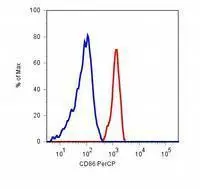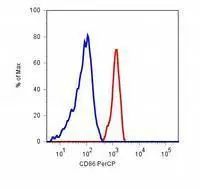CD86 antibody [BU63]
GTX74650
ApplicationsFlow Cytometry, ImmunoFluorescence, ImmunoPrecipitation, Western Blot, ImmunoCytoChemistry, ImmunoHistoChemistry, ImmunoHistoChemistry Frozen
Product group Antibodies
TargetCD86
Overview
- SupplierGeneTex
- Product NameCD86 antibody [BU63]
- Delivery Days Customer9
- Application Supplier NoteIHC-Fr: 1/20-1/100. FACS: 1/20-1/100. *Optimal dilutions/concentrations should be determined by the researcher.Not tested in other applications.
- ApplicationsFlow Cytometry, ImmunoFluorescence, ImmunoPrecipitation, Western Blot, ImmunoCytoChemistry, ImmunoHistoChemistry, ImmunoHistoChemistry Frozen
- CertificationResearch Use Only
- ClonalityMonoclonal
- Clone IDBU63
- Concentration1 mg/ml
- ConjugateUnconjugated
- Gene ID942
- Target nameCD86
- Target descriptionCD86 molecule
- Target synonymsB7-2, B7.2, B70, CD28LG2, LAB72, T-lymphocyte activation antigen CD86, B-lymphocyte activation antigen B7-2, BU63, CD86 antigen (CD28 antigen ligand 2, B7-2 antigen), CD86 v6, CTLA-4 counter-receptor B7.2, FUN-1
- HostMouse
- IsotypeIgG1
- Protein IDP42081
- Protein NameT-lymphocyte activation antigen CD86
- Scientific DescriptionThis gene encodes a type I membrane protein that is a member of the immunoglobulin superfamily. This protein is expressed by antigen-presenting cells, and it is the ligand for two proteins at the cell surface of T cells, CD28 antigen and cytotoxic T-lymphocyte-associated protein 4. Binding of this protein with CD28 antigen is a costimulatory signal for activation of the T-cell. Binding of this protein with cytotoxic T-lymphocyte-associated protein 4 negatively regulates T-cell activation and diminishes the immune response. Alternative splicing results in several transcript variants encoding different isoforms.[provided by RefSeq, May 2011]
- Storage Instruction-20°C or -80°C,2°C to 8°C
- UNSPSC12352203
References
- Impact of Isolation Procedures on the Development of a Preclinical Synovial Fibroblasts/Macrophages in an In Vitro Model of Osteoarthritis. Manferdini C et al., 2020 Dec 10, Biology (Basel)Read more
- NLRP7 Is Involved in the Differentiation of the Decidual Macrophages. Tsai PY et al., 2019 Nov 28, Int J Mol SciRead more
- Serum levels of osteopontin predict major adverse cardiovascular events in patients with severe carotid artery stenosis. Carbone F et al., 2018 Mar 15, Int J CardiolRead more
- Intestine-Specific Homeobox Gene ISX Integrates IL6 Signaling, Tryptophan Catabolism, and Immune Suppression. Wang LT et al., 2017 Aug 1, Cancer ResRead more
- Proinflammatory Vdelta2+ T cells populate the human intestinal mucosa and enhance IFN-gamma production by colonic alphabeta T cells. McCarthy NE et al., 2013 Sep 1, J ImmunolRead more
- Rapamycin conditioning of dendritic cells differentiated from human ES cells promotes a tolerogenic phenotype. Silk KM et al., 2012, J Biomed BiotechnolRead more
- Maturation of monocyte derived dendritic cells with OK432 boosts IL-12p70 secretion and conveys strong T-cell responses. Hovden AO et al., 2011 Jan 5, BMC ImmunolRead more
- Increased intracellular growth of Mycobacterium avium in HIV-1 exposed monocyte-derived dendritic cells. Salte T et al., 2011 Mar, Microbes InfectRead more
- Induction of a CD8+ T-cell response to the MAGE cancer testis antigen by combined treatment with azacitidine and sodium valproate in patients with acute myeloid leukemia and myelodysplasia. Goodyear O et al., 2010 Sep 16, BloodRead more
- Neuronal nitric oxide synthase modulates maturation of human dendritic cells. Adler HS et al., 2010 Jun 1, J ImmunolRead more

![FACS analysis of human peripheral blood using GTX00600-06 CD86 antibody [BU63] (FITC).](https://www.genetex.com/upload/website/prouct_img/normal/GTX00600-06/GTX00600-06_20191025_AP_006_104_w_23053121_942.webp)
![FACS analysis of human peripheral blood using GTX80210 CD86 antibody [BU63] (APC).](https://www.genetex.com/upload/website/prouct_img/normal/GTX80210/GTX80210_20191025_AP_006_424_w_23061322_738.webp)

